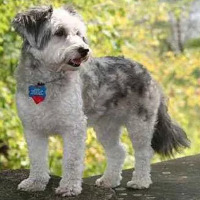Appearance of the Sheltidoodle
|
| The Sheltidoodle is a medium-sized dog derived from two dogs whose appearance can be very different, resulting in great variation between dogs, even within the same litter. Both parent breeds are rather well built, with long, straight legs and deep chests, which will also be the case with their offspring. The head and face of the Shetland Sheepdog are quite divergent from those of the Poodle, and the hybrid may take its inspiration from the Sheltie, with a wedge-shaped head and a long, tapering muzzle rounded at the tip, or from the Poodle with a narrower, domed head and a straight, fine muzzle; it may even take on characteristics of both parents. Its eyes are generally medium-sized and oval or almond-shaped, and although most are dark brown, some Shelties can pass on blue or two-tone eyes, especially if they have merle coloration, and they can inherit the straight, triangular ears of the Shetland Sheepdog, the longer floppy ears of the Poodle, or an intermediate color. |
Temperament of the Sheltidoodle
|
| The Sheltidoodle is generally a well-behaved animal, particularly attentive and receptive. These characteristics, combined with its high intelligence, make it an extremely easy animal to train, provided you use gentle training techniques. However, they are prone to separation anxiety and boredom if given insufficient mental stimulation or left alone for too long. They generally react to strangers in a polite but reserved manner, with mild but sensitive protective instincts. Early and thorough socialization helps prevent their naturally reserved nature from turning into excessive vigilance or unwarranted shyness, but some dogs can still develop hypersensitivity to touch, fast movements or loud noises, so they may not be the best choice for very young or particularly active children. They are generally peaceful with other animals, including other dogs, although some may give in to the urge, inherent in shepherd breeds and their offspring, to chase and herd other animals. |
Needs and activities of the Sheltidoodle
|
| The Sheltidoodle is a fairly fast and energetic breed, and while the Poodle is not as relentlessly active as some Retriever breeds, they are still athletic dogs that need daily physical activity to remain healthy and stable. While one hour of physical activity a day should meet your Sheltidoodle's exercise needs, it's important to exercise his intellect on a daily basis. You can combine physical and mental training with these dogs by practicing activities such as canine acrobatic dance, agility classes, retrieving and field trials, herding activities, as well as obedience and advanced exercises. Although this dog can adapt to life in an apartment, it will need extra exercise every day and early training to avoid excessive vocalization. Most Sheltidoodles will be much happier in a larger home with a garden to run around in. |
Maintenance of the Sheltidoodle
|
| One of the biggest differences between the two related breeds is the difference between their coats. The Sheltie has a double-layered coat, composed of an extremely dense undercoat that pushes an outer coat of long, straight hair all over the body, except on the face and lower legs, where the hair is short and lies flat against the skin. The Poodle, on the other hand, has a single layer of curly hair all over its body, which sheds very little but never stops growing. While the Sheltidoodle generally has a curly or wavy coat, the coat may be single- or double-layered, and the actual structure of the coat may resemble either of the parent breeds. Dogs that have inherited the double-layered coat of the Sheltie breed shed more and require more frequent brushing than their single-layered counterparts, while those that have inherited the ever-growing coat of the Poodle will need to be clipped or trimmed regularly and washed more frequently than those whose coat structure is coarser than that of the Shetland Sheepdog. |









 English (United Kingdom)
English (United Kingdom)